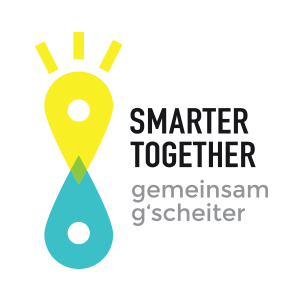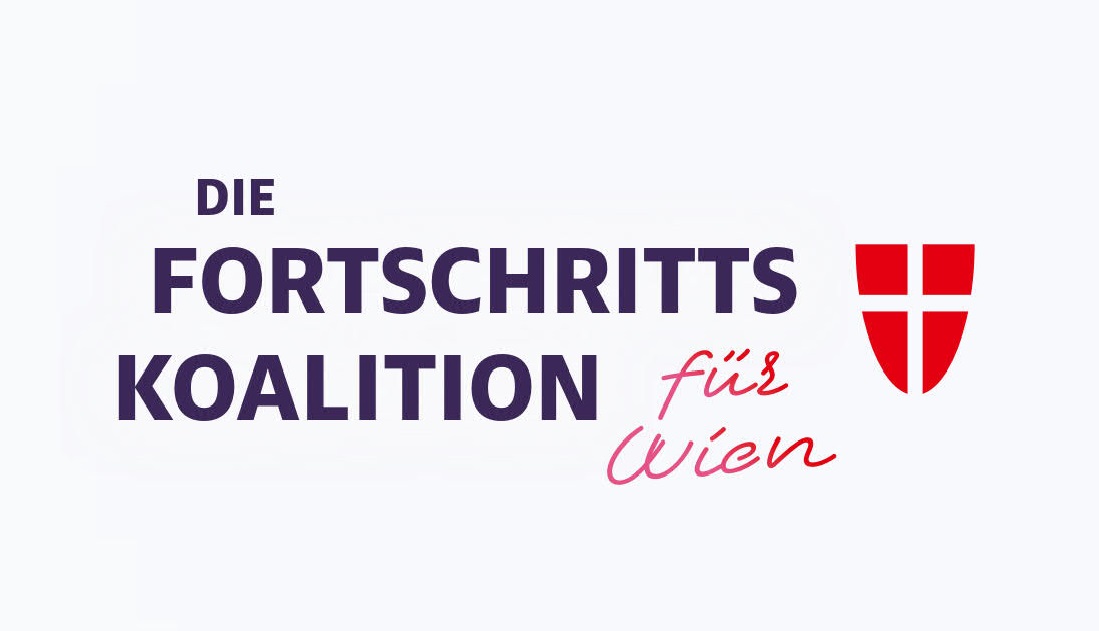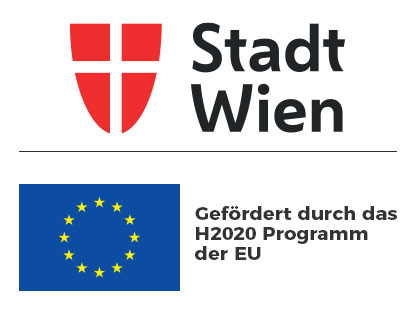Smarter Together – Gemeinsam g’scheiter im Wiener Regierungsprogramm 2020
Regierungs-abkommen 2020
Vom E-Carsharing bis Smarter Together 3.0
Zahlreiche Themen und Ansätze von Smarter Together finden sich im Regierungsabkommen der Wiener Stadtregierung vom November 2020 wieder. Herausragen natürlich die konkreten Folgeprojekte der Stadt Wien wie WieNeu+ (im Gemeinderatsbeschluss als „smarter together 2.0“ bezeichnet) oder Hauskunft. Der neue Stadtentwicklungsplan 2035 wird gar als „Smarter Together 3.0“ betitelt.
Jedenfalls ist und war Smarter Together – Gemeinsam g’scheiter im Trend der Zeit. Dabei stützte sich das Projekt in vielen Teilen auf die lange Tradition von Innovation und Partizipation der Stadt Wien und seiner Magistratsabteilungen und konnte in konkreten Umsetzungsprojekten verschiedene Aspekte konkret umsetzen oder vertiefen. Zudem konnte das Projekt durchaus auch weitere Potentiale aufzeigen. Weil es ein von der EU gefördertes Projekt ist, war es eine EU-Vorgabe, gleichsam international auszustrahlen. Damit konnte Smarter Together – Gemeinsam g‘scheiter zum Image Wiens als zukunftsorientierte lebenswerte Stadt mit außerordentlichem Entwicklungspotential beitragen.
Drei wesentliche Vorgaben
Drei wesentlichen Vorgaben hatten die Konzeption und die Umsetzung des Projektes Smarter Together – Gemeinsam g’scheiter in Wien nachhaltig beeinflusst:
Zunächst war da die äußerst breit konzipierte Ausschreibung „Smart Cities and Communities“ (SCC) im Rahmen des Programms „Horizon 2020“ der Europäischen Kommission. Dabei wurde visionär die Smart City und Klimapolitik in konkreten, messbaren Umsetzungsmaßnahmen eingefordert, die gleichzeitig als Ausgangspunkt für weitere Schritte dienen sollten – Stichwort „Replication“.
Die Stadt Wien sah im Projekt die Möglichkeit, die eigene und von vielen als äußerst innovativ und sozial nachhaltig angesehene Smart City Rahmenstrategie einem Praxistest zu unterziehen, um daraus weitere konkrete Maßnahmen abzuleiten – Stichwort Nachhaltigkeit.
Und schließlich war es der politische Auftrag bei der Ausgestaltung des Projektes insbesondere der Partizipation, d.h. der BürgerInnen-Beteiligung, einen zentralen Stellenwert beizumessen. Stichwort Mensch und Umwelt im Mittelpunkt.
Ein „Urban Living Lab“ im Realbetrieb
Ergebnis war ein partizipativer Innovationsprozess, ein sog. „Urban Living Lab“, im großen Maßstab und im Realbetrieb, der vielfach ausstrahlt: das Projekt Smarter Together – Gemeinsam g’scheiter mit über 40 Teilprojekten und einem Gesamtinvestitionsvolumen von über 80 Mio. Euro sowie um die 38.000 (persönlichen) Kontakten. Insgesamt war das Bestreben, die Ergebnisse der Einzelprojekte in nachhaltige Prozesse zu überführen.
Das Regierungsprogramm umfasst folgende Kapitel: Stadt der Arbeit und Wirtschaft, Stadt der Bildung, Lebenswerte Musterstadt, Weltoffene Kulturstadt, Leistbare Stadt, Smart City, Stadt des sozialen Zusammenhalts, Transparente Stadt.
Gelebte Zukunftsvisionen
Smarter Together-Themen finden sich in allen Kapiteln, was der Breite des Projektes zugeschrieben werden kann. Im Kapitel „Stadt der Arbeit“ sind es insb. die „Grätzl-Offensive: Lokale Wirtschaft stärken“ und „urbane Lösungen im europäischen Kontext“. Besonders oft finden sich Smarter Together-Themen im Kapitel „Stadt der Bildung“, wo es u.a. heißt „Kindern Paläste bauen“, „coole Bildungseinrichtungen für coole Kids & Pädagog_innen“, „vom Bildungsgrätzl zur Bildungsstadt“ oder „Lust auf Wissenschaft machen“. Als Smart City-Projekt findet sich Smarter Together auch im Kapitel zur „lebenswerten Klimamusterstadt“ u.a. beim „Wiener Klimapakt“, „Energieversorgung aus erneuerbaren Quellen“, „Dekarbonisierung“, „thermische Sanierung“, „Leuchtturmprojekte“ sowie „nachhaltige Entwicklung“ zur Erreichung der SDGs. Obwohl nicht direkt ein Smart City-Thema, finden sich Smarter Together-Themen auch im Kapitel zur „weltoffenen Kulturstadt“ u.a. mit Themen wie „öffentlicher Raum“, „kooperative Entwicklungsprozesse“, „inklusive Teilhabe“ und „diversitätsorientierte Stadt – Integration als Querschnittsmaterie“. Im Kapitel „leistbare Stadt“ spiegelt sich Smarter Together in seiner Gesamtheit, wobei bereits Nachfolgeprojekte wie „WieNeu+“ und „Hauskunft“ ebenso prominent hervorgehoben werden wie Teilaspekte, so die „verstärkte Nutzung des Photovoltaik-Potentials auf Gemeindebauten“. Das Kapitel „Smart City“ umfasst Themenbereiche wie „Smart City Rahmenstrategie“, „Innovationen in der Smart City“, „Bürger_innenbeteiligung und Partizipation“ und „smarte Mobilität“. Der Stadtentwicklungsplan 2035 wir als „Smarter together 3.0“ bezeichnet. In den Kapiteln „sozialer Zusammenhalt“ und „transparente Stadt“ finden sich zwar nicht unmittelbar projektbezogen Anknüpfungspunkte, doch konnte Smarter Together etwa mit dem Bewegungsspiel „Beat the Street“ alle Bevölkerungsgruppen in Simmering um ein gemeinsames Ziel vereinen. Mit der smartdata.wien-Plattform oder der Projektkommunikation wurde die transparente Stadt gelebt.
English Summary / Zusammenfassung in Englisch:
Smarter Together in the new Governance Agreement 2020
From e-car sharing to Smarter Together 3.0 Numerous topics and approaches of Smarter Together can be found in the new Government Agreement of the Vienna City Government of November 2020. There are for instance the concrete follow-up projects of the City of Vienna such as „WieNeu+“ (referred to as „smarter together 2.0“ in the municipal council resolution) or „Hauskunft“. The new Urban Development Plan 2035 is even called „Smarter Together 3.0“. Three essential requirements An „Urban Living Lab“ in real operation The new government programme comprises the following chapters: City of Work and Economy, City of Education, Model City, Cosmopolitan City of Culture, Efficient City, Smart City, City of Social Cohesion, Transparent City. Living visions of the future
Smarter Together is and has always been a trend of the times. However, evidently, the project was based on the long tradition of innovation and participation of the City of Vienna and its municipal departments and was able to implement or deepen various aspects in concrete implementation projects. In addition, the project was also able to identify further potential. Because it is an EU-funded project, it was an EU requirement that it should have an international outreach. Smarter Together was thus able to contribute to Vienna’s image as a future-oriented, liveable city with extraordinary development potential.
Three essential requirements had a lasting influence on the conception and implementation of the project Smarter Together in Vienna:
Firstly, there was the extremely broadly conceived call for proposals „Smart Cities and Communities“ (SCC) within the framework of the European Commission’s „Horizon 2020“ programme. This was a visionary call for smart city and climate policy to be translated into concrete, measurable implementation measures, which at the same time should serve as a starting point for further steps – keyword „replication“.
The City of Vienna saw the project as an opportunity to subject its own Smart City framework strategy, which many considered to be extremely innovative and socially sustainable, to a practical test in order to derive further concrete measures – keyword „sustainability“.
And finally, it was the political mandate to attach a central importance to participation, i.e. citizen involvement, in the design of the project. The focus is on people and the environment.
The result was a participatory innovation process, a so-called „Urban Living Lab“, on a large scale and in real life, which has a multiple impact: the project Smarter Together with over 40 sub-projects and a total investment volume of over 80 million euros as well as around 38,000 (personal) contacts. The overall aim was to transfer the results of the individual projects into sustainable processes.
Smarter Together themes can be found in all chapters, which can be attributed to the breadth of the project. In the chapter „City of Work„, the focus is on the „District Area focus: Strengthening the Local Economy“ and „Urban Solutions in a European Context“. Smarter Together topics are particularly often found in the chapter „City of Education„, where it says, among other things, „building palaces for children“, „cool educational institutions for cool kids and teachers“, „from the district area to the city of education“ or „making science fun“. As a Smart City project, Smarter Together can also be found in the chapter on the „Climate Model City Worth Living In“ in the „Vienna Climate Pact“, „energy supply from renewable sources“, „decarbonisation“, „thermal refurbishment“, „lighthouse projects“ and „sustainable development“ to achieve the SDGs. Although not directly a Smart City theme, Smarter Together themes can also be found in the chapter on the „Cosmopolitan City of Culture“ with topics such as „public space“, „cooperative development processes“, „including participation“ and „diversity-oriented city – integration as a cross-cutting issue“. In the chapter „Affordable City„, Smarter Together is reflected in its entirety, with follow-up projects such as „WieNeu+“ and „Hauskunft“ being highlighted just as prominently as partial aspects, such as the „increased use of photovoltaic potential on municipal buildings“. The „Smart City“ chapter covers topics such as the „Smart City Framework Strategy“, „Innovations in the Smart City“, „Citizen Involvement and Participation“ and „Smart Mobility“. The urban development plan 2035 is referred to as „Smarter together 3.0„. Although the chapters „Social Cohesion“ and „Transparent City“ do not contain any directly project-related points of reference, Smarter Together was able to unite all population groups in Simmering around a common goal with the mobility game „Beat the Street“. With the smartdata.wien platform or the project communication, the transparent city was lived out.
Bojan Schnabl



 MA 25
MA 25 MGS
MGS